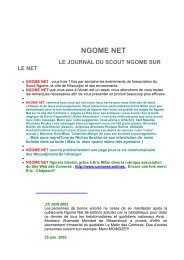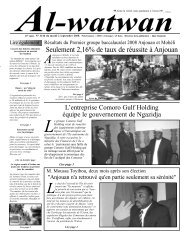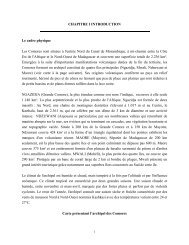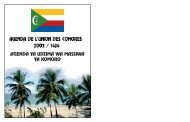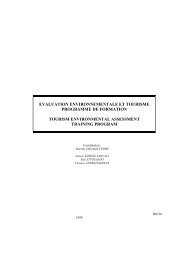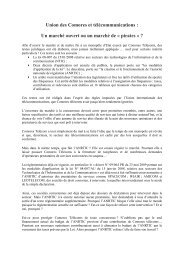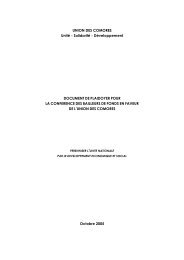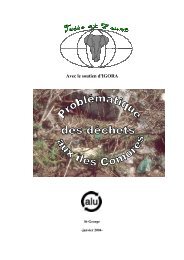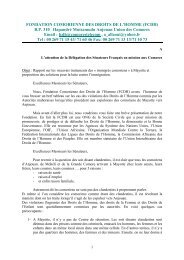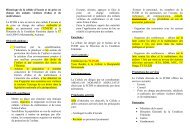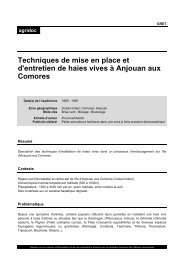Guide économique des Comores au format .pdf - Présidence de l ...
Guide économique des Comores au format .pdf - Présidence de l ...
Guide économique des Comores au format .pdf - Présidence de l ...
- No tags were found...
You also want an ePaper? Increase the reach of your titles
YUMPU automatically turns print PDFs into web optimized ePapers that Google loves.
Sommaire/SummaryUnion <strong><strong>de</strong>s</strong> <strong>Comores</strong>Union <strong><strong>de</strong>s</strong> <strong>Comores</strong>... Généralités ... p.3h Présentationh Données généralesh Des données Macro-EconomiquesLa coopération régionale ................ p.5h La Commission <strong>de</strong> l'Océan Indienh Le marché commun <strong>de</strong> l’Afrique <strong>de</strong> l’est et Australe(COMESA)h Importance du secteur agro-alimentaireDonnées sectorielles .................... p.5-7h Opportunités du secteur agro-alimentaireh Le Tourismeh Secteur <strong>de</strong> servicePromotion <strong><strong>de</strong>s</strong> investissements p.9-11-13h Les échanges extérieursh Investir <strong>au</strong>x <strong>Comores</strong>h Système financierh L'entrée <strong>au</strong>x comores et le séjour <strong><strong>de</strong>s</strong> étrangersh Système foncierh Main d’oeuvre et lois socialesh Système douanierh Droit <strong><strong>de</strong>s</strong> sociétésh La garantie <strong><strong>de</strong>s</strong> investissementsh La fiscalitéPartenariats et institutions ........ p.15-17h Les bailleurs <strong>de</strong> fondsh InstitutionsCoûts <strong><strong>de</strong>s</strong> facteurs ..................... p.17-19h Transportsh Structure tarifaireh Impositionsh T<strong>au</strong>x d’intérêtsh Loyersh Tarifs hôtelliersh Main d’oeuvreh Electricitéh E<strong>au</strong>h Produits pétroliersh Télécommunicationh T<strong>au</strong>x <strong>de</strong> change (moyenne)Union of ComorosGeneral points ................................ p.4h Formath General datash Macro-economic datasRegional cooperation ...................... p.6h The indian ocean commissionh The common market for eastern and southern africa(COMESA)Sectoral datas ................................ p.6h Tourismh Service sectorThe promotion of investments p.10-12-14h Tourismh Service sectorh Financial systemh Entry and stay in the comorosh Land allocation systemh Labour and social lawsh Customs systemh Companies rightsh Investments guaranteeh Tax systemPartnerships and institutions ......... p.16h Donorsh InstitutionsFactors costs ............................. p.18-20h Transportsh Tariff structuresh Taxationsh Interests Ratesh Renth Hotel Faresh Labourh Electricityh Waterh Oil productsh Télécommunicationsh Exchange rates (average)
Union <strong><strong>de</strong>s</strong> <strong>Comores</strong> 2003<strong>Gui<strong>de</strong></strong> économique2Unité - Solidarité - Développement.......................Mot du vice-prési<strong>de</strong>nt<strong>de</strong> L’Union <strong><strong>de</strong>s</strong> <strong>Comores</strong>chargé <strong>de</strong> l’économie <strong><strong>de</strong>s</strong> financesCe document se veut un outil essentiel pour véhiculerles in<strong>format</strong>ions économiques et sociales pour tousceux qui s'intéressent à l'investissement <strong>au</strong>x <strong>Comores</strong>.Les <strong>Comores</strong> ayant retrouvé la stabilité à travers un processus<strong>de</strong> réconciliation nationale qui est en cours <strong>de</strong>consolidation, adoptent <strong><strong>de</strong>s</strong> politiques économiques etfinancières rigoureuses et mettent en place <strong><strong>de</strong>s</strong> mécanismesvisant à améliorer le climat global <strong><strong>de</strong>s</strong> affaires.Ainsi, nous nous employons à contribuer à l'établissementd'un cadre juridique fiable qui permette <strong>au</strong>x opérateurséconomiques <strong>de</strong> prendre <strong><strong>de</strong>s</strong> risques calculés.Dans ce cadre l'intégration économique régionale apparaîtcomme un objectif prioritaire qui <strong>de</strong>vrait permettre<strong>au</strong>x opérateur économiques un marché plus vaste quiseul peut améliorer la rentabilité <strong><strong>de</strong>s</strong> investissementsdans un contexte <strong>de</strong> globalisation.Nous sommes conscients que be<strong>au</strong>coup reste à fairec'est pourquoi nous poursuivons et amplifions nosactions pour améliorer les conditions <strong>de</strong> fourniture <strong>de</strong>l'énergie, encourager toute initiative visant à stimuler lesinvestissements et favoriser les transferts <strong><strong>de</strong>s</strong> connaissanceset <strong><strong>de</strong>s</strong> technologies.Je souhaite que ce gui<strong>de</strong> suscite un grand intérêt etouvre d'heureuses perspectives pour notre cher pays.Unity - Solidarity - Development.......................Note by the vice presi<strong>de</strong>ntof the Union of the Comorosin charge of financeThis document is an essential tool aiming at providingeconomic and social in<strong>format</strong>ion to those who are interestedin investing in the Comoros.The Comoros, which is consolidating its stability restoredthrough a process for national reconciliation, hasadopted strict economic and financial policies and is setting-upmechanisms aiming at improving the businessglobal climate.To this end, we are spending our time on contributing tothe setting-up of a legal framework which will enableeconomic operators to take less risks. In this context,the regional economic integration seems to be the prioritywhich will enable economic operators to haveaccess to a larger market which, alone, can increase theprofitability of investments in a global context.We are aware of the fact that much work is still to bedone. For this reason we continue increasing ouractions in view of improving the conditions of supply ofenergy, encouraging any initiative which will stimulateinvestments, and favour the transfers of knowledgesand technologies.I hope that this gui<strong>de</strong> will arise a lot of interests and bringhappy opportunities to our country.CAABI ELYACHROUTU MohamedVice-Prési<strong>de</strong>nce, chargée <strong><strong>de</strong>s</strong> Finances, Budget,De l'Economie, du Commerce extérieur, <strong><strong>de</strong>s</strong>Investissements et <strong><strong>de</strong>s</strong> Privatisations
3<strong>Gui<strong>de</strong></strong> économique Union <strong><strong>de</strong>s</strong> <strong>Comores</strong> 2003Union <strong><strong>de</strong>s</strong> <strong>Comores</strong>... GénéralitésPrésentationL’Archipel <strong><strong>de</strong>s</strong> <strong>Comores</strong> composé <strong>de</strong> 4 îles <strong>de</strong> l'Océan Indien, se situe dans le canal <strong>de</strong> Mozambique entre lecôté Est africain et le Nord <strong>de</strong> Madagascar. Ces îles sont : Gran<strong>de</strong> <strong>Comores</strong>, Anjouan, Mohéli, Mayotte (encoresous administration française). Ancienne colonie française, les <strong>Comores</strong> sont <strong>de</strong>venues indépendantes<strong>de</strong>puis le 6 juillet 1975.Données généralesg Ville principales :g Capitale :Moroni (Gran<strong>de</strong> <strong>Comores</strong>) - Mutsamudu (Anjouan) - Fomboni (Mohéli)Dzaoudzi (Mayotte).Moronig Superficie : 2236 km² repartie entre la Gran<strong>de</strong> <strong>Comores</strong> (1148 km²), Anjouan (424km²), Mohéli (290 km²) et Mayotte (374 km²).g Population :g Constitution :g Pour chaque île <strong>au</strong>tonome :g Densité :g Monnaie nationale :652 000 habitants (selon les <strong>de</strong>rnières estimations). Gran<strong>de</strong> <strong>Comores</strong>(44%), Anjouan (36,4%), Mohéli (4,7%), et Mayotte (14,4%)23/12/01 instituant un Gouvernement fédéral et <strong><strong>de</strong>s</strong> gouvernement <strong>au</strong>tonome <strong>au</strong> nive<strong>au</strong> <strong>de</strong> chaque île.un gouvernement gère les affaires internes.292 habitants/km²Le franc comorien (0,15 Euro = 75 Kmf)g Climat : Le climat <strong>de</strong> l'archipel <strong><strong>de</strong>s</strong> <strong>Comores</strong> est <strong>de</strong> type tropical humi<strong>de</strong> avec :g La végétation <strong><strong>de</strong>s</strong> îles : Elle se répartie comme suit :h Une saison ch<strong>au</strong><strong>de</strong> et humi<strong>de</strong> <strong>de</strong> novembre à maih Une saison fraîche et sèche <strong>de</strong> juin à octobreh La température moyenne annuelle est <strong>de</strong> 25°Ch Une forêt <strong>de</strong>nse <strong>de</strong> type tropical humi<strong>de</strong> en altitu<strong>de</strong>.h Des régimes <strong>de</strong> bananiers sous bois et cocotiers danstoutes les régions côtières.g Langue :Les langues officielles sont le comorien, le français et l'arabe.La langue comorienne est dérivée <strong>de</strong> l'arabe et du swahiliparlé en Afrique orientale.Des données Macro-Economiquesg PIB (<strong>au</strong> prix constant <strong>de</strong> 2001) :121 003 millions DE FRANCS COMORIENS.g T<strong>au</strong>x <strong>de</strong> croissance du PIB (en %) : +2,1% en 2001 et 3% en 2002g Investissement brut en % du PIB : 18%h Secteur primaire en pourcentage : 40,9%h Secteur secondaire en pourcentage : 11,9%h Secteur tertiaire en pourcentage : 47,1%
Union <strong><strong>de</strong>s</strong> <strong>Comores</strong> 2003<strong>Gui<strong>de</strong></strong> économiqueUnion of Comoros... General points4FormatThe Comoros archipelago consists of 4 islands located in the Indian Ocean, in the Mozambique Channel betweenthe East of Africa and the North of Madagascar. These islands are: Grand Comoro, Anjouan, Moheli andMayotte (which is still un<strong>de</strong>r French <strong>au</strong>thority). The Comoros, a former French colony became in<strong>de</strong>pen<strong>de</strong>nton July 6th, 1975.General datasg The main cities of the Comoros are the followings:g Capital of the Comoros is:g Area:g The population:g A Government runsg Density:g Currency:g Climate:Moroni (in Grand Comoro), Mutsamudu (in Anjouan),Fomboni (in Moheli) and Dzaoudzi (in Mayotte).Moroni2236 square kilometres divi<strong>de</strong>d as follows: GrandComoro: 1148 square kilometres - Anjouan: 424 squarekilometres - Moheli: 290 square kilometres - Mayotte: 374square kilometres.652.000 inhabitants divi<strong>de</strong>d as follows: Grand Comoro(44%), Anjouan (36%), Moheli (4,7%) and Mayotte(14,4%).the domestic affairs of each Autonomous Island.292 inhabitants per square kilometrethe comorian franc (Kmf): 1FF = 75 Kmf = 0,15eurosthe climate of the Archipelago is humid and tropical with:h a humid and hot season from November till Mayh a dry and fresh season from June to Octoberh the average annual temperature is 25°cg The island vegetation is as follows:h a humid and tropical thick forest at high altitu<strong>de</strong>h bananas stems and coconut trees in all the coastalareasg Languages:The Comorian language, Arabic and French are theofficial languages. The comorian language is <strong>de</strong>rivedfrom Arabic and Swahili which spoken in East Africa.Macro-economic datasg GDP (steady prices in 2001):121.003 millions comorian francsg GDP growth rate (in percentage): +2.1% in 2001 and 3% in 2002.h Primary sector: 40.9 %h Secondary sector: 11.9%h Tertiary sector: 47.1%
5La coopération régionale<strong>Gui<strong>de</strong></strong> économique Union <strong><strong>de</strong>s</strong> <strong>Comores</strong> 2003Données sectoriellesLes <strong>Comores</strong> ont amorcé <strong>de</strong>puis 1982 un processusd'intégration économique régionale avec les pays <strong>de</strong>l'Afrique <strong>de</strong> l'Est, <strong>de</strong> l'Australe et <strong>de</strong> l'Océan Indien. A cejour les <strong>Comores</strong> ont adhéré à 3 groupements sousrégion<strong>au</strong>x qui concourent à favoriser la création d'unenvironnement économique, financier et juridique harmonisé<strong><strong>de</strong>s</strong> pays concernés à faire valoir nos potentialitéscommunes sur les marchés mondi<strong>au</strong>x.La Commission <strong>de</strong> l'Océan IndienLes <strong>Comores</strong> ont adhéré en 1986 la commission <strong>de</strong>l'Océan Indien (COI) qui regroupe cinq pays <strong>de</strong> la sous- région (Madagascar, île M<strong>au</strong>rice, Réunion, lesSeychelles et les <strong>Comores</strong>) dans un accord <strong>de</strong> coopérationrégionale.Les <strong>Comores</strong> ont participé <strong>au</strong> programme régional <strong>de</strong>développement <strong><strong>de</strong>s</strong> échanges (PRIDE) et a pris part àtoutes les manifestations organisées à cet effet, àsavoir les salons professionnels et les Foires organisésdans la région.h Un service <strong>de</strong> norme et qualité est crée <strong>au</strong> Ministre<strong>de</strong> l'industrie sous l'appui du projet PRIDE, mais n'estpas encore fonctionnel.h Les <strong>Comores</strong> ont participé <strong>au</strong> programme régional <strong>de</strong>l'environnement et <strong>de</strong> développement du tourisme.Le marché commun <strong>de</strong> l’Afrique <strong>de</strong> l’est etAustrale (COMESA)g Les <strong>Comores</strong> ont contribué à l'inst<strong>au</strong>ration du marchécommun <strong>de</strong> l'Afrique <strong>de</strong> l'Est et Austral (COMESA) qui arelayé l'entité initiale Zone d'Echange Préférentiels(ZEP) et a signé le traité en 1994.g Ils ont souscris à tous les programmes du COMESArelatifs à l'harmonisation <strong><strong>de</strong>s</strong> politiques monétaires telsque l'établissement d'un système <strong>de</strong> paiement et <strong>de</strong>règlement COMESA - Compass qui permettra la réduction<strong><strong>de</strong>s</strong> coûts <strong><strong>de</strong>s</strong> transactions commerciales et <strong><strong>de</strong>s</strong>risques inhérents à la convertibilité <strong><strong>de</strong>s</strong> monnaies, lacréation d'un bure<strong>au</strong> SWIFT pour les transactions sûreset instantanées et le projet <strong>de</strong> facilitation du commercerégional (PFCR).g Les <strong>Comores</strong> Participent <strong>au</strong> Forum pour la facilitation<strong>de</strong> l'Intégration Régionale dont l'objectif est la libre circulation<strong><strong>de</strong>s</strong> biens, <strong><strong>de</strong>s</strong> personnes et <strong><strong>de</strong>s</strong> capit<strong>au</strong>x enAfrique <strong>de</strong> l'Est <strong>de</strong> l'Australe et dans l'Océan Indien.Importance du secteur agro-alimentaireLa contribution <strong>de</strong> l'agriculture à l'économie comorienneest significative en terme <strong>de</strong> <strong>format</strong>ion du PIB‚ d'emplois‚<strong>de</strong> satisfaction <strong><strong>de</strong>s</strong> besoins alimentaires <strong>de</strong> baseet <strong>de</strong> recettes d'exportation. Elle génère environ 40% duPIB‚ 80% <strong><strong>de</strong>s</strong> emplois et près <strong>de</strong> 90% <strong><strong>de</strong>s</strong> recettes budgétaires.h Les cultures vivrières contribuent pour environ 47%<strong>de</strong> la valeur ajoutée du secteur agricole <strong>au</strong> sens large.h On estime la contribution <strong>de</strong> la pêche à 21%h Les cultures <strong>de</strong> rente à 13%h et l'élevage à 8%.Le transport inter-îles dispose actuellement <strong>de</strong> 23bate<strong>au</strong>x d'une capacité moyenne <strong>de</strong> 25 tonnes.Opportunités du secteur agro-alimentaireLes principales opportunités sont les suivantes :h Le climat est tropical humi<strong>de</strong> et fortement influencépar le relief et son insularité. La pluviométrie varie entre1600 et 2700 mm par an. Les précipitations sont répartiessur toute l'année.h Les écarts <strong>de</strong> prix <strong><strong>de</strong>s</strong> produits agricoles entre les îlessont <strong>de</strong> nature à favoriser les échanges et la spécialisation.Sans entrave <strong>au</strong> commerce‚ cette situation <strong>de</strong>vraitbénéficier <strong>au</strong>x consommateurs.h Le pays dispose d'une stratégie agricole opérationnelle.h On dénombre entre 40 000 et 50 000 exploitationsagricoles réparties à raison <strong>de</strong> 60% en Ngazidja‚ 35% àNdzuwani et 5% à Mwali.g Le cas <strong><strong>de</strong>s</strong> cultures <strong>de</strong> renteBois 11%Pêche 21%Cultures vivrières 47%Cultures <strong>de</strong> rente 13%Élevage 8%Les cultures <strong>de</strong> rente (vanille, ylang-ylang et girofle)génèrent environ 98 % <strong>de</strong> la valeur <strong><strong>de</strong>s</strong> exportationscomoriennes. La production <strong><strong>de</strong>s</strong> cultures <strong>de</strong> rente fluctue<strong>de</strong> manière importante d'une année à l'<strong>au</strong>tre en raison<strong><strong>de</strong>s</strong> techniques <strong>de</strong> production et <strong><strong>de</strong>s</strong> cours mondi<strong>au</strong>x.Cela a <strong><strong>de</strong>s</strong> répercussions importantes sur lesrecettes d'exportation‚ la balance commerciale et lesrevenus <strong><strong>de</strong>s</strong> producteurs.
Union <strong><strong>de</strong>s</strong> <strong>Comores</strong> 2003Regional cooperation<strong>Gui<strong>de</strong></strong> économiqueSectoral datas6The Comoros has initiated a process for regional economicintegration since 1986, with the countries of Eastand Southern Africa and the Indian Ocean. To date, theComoros is a member of three sub-regional groupingsworking towards establishing a harmonised legal, financialand economic environment within the involvedcountries, in view of promoting our potentials on the globalmarkets.The indian ocean commissionThe Comoros became member of the Indian OceanCommission (IOC) in 1986, a commission uniting fivecountries from the sub-region: Madagascar, M<strong>au</strong>ritius,Reunion, Seychelles, Comoros, through a regionalcooperation agreement.The Comoros took part in the regional programme onthe <strong>de</strong>velopment of exchanges (PRIDE) and took alsopart in all the festivities organised for this end, namelyprofessional shows and fairs organised in the region.h A standard and quality service was set up in theMinistry of Industry with the support of the projectPRIDE.h The Comoros took part in the regional programme onthe Environment and for the <strong>de</strong>velopment of Tourism.The common market for eastern and southernafricag The Comoros has contributed to the setting-up of theCommon Market for Eastern and Southern Africa,COMESA, which has taken over the initial entity, thePreferential Exchange Zone (ZEP). The country alsosigned the COMESA Treaty in 1994.g The country subscribed to all the COMESA programmespertaining to the harmonisation of monetary policies,such as the setting-up of a payment and settlingCOMESA system, which will favour the reduction oftra<strong>de</strong> transaction costs and the risks inherent to theconvertibility, the creation of a SWIFT office for safetransactions and the project for the facilitation of regionalcommerce (PFCR).g The Comoros took part in the forum for the facilitationof Regional Integration in favour of the free movementof goods, people and money, in East and SouthernAfrica and in the Indian Ocean.Importance of the agri business sectorThe contribution of the agriculture in the economy ofthe Comoros is significant in terms of the <strong>format</strong>ion ofthe GDP, employment and satisfaction of the basicneeds for food, exports and revenues. It provi<strong><strong>de</strong>s</strong>about 4% of the GDP, 80% of the employment andclose to 90% of the revenues.h Alimentation farming constitues about 47% of thetotal value of the agricultural sector.h Fishing constitutes about 21%h Commercial farming 13%h Breeding 8%h Inter island transportation is provi<strong>de</strong>d by 23 mediumsized boats with a 25 ton capacity.Opportunities in the agri businessThe principal opportunities are as follow:h The climate is tropical and humid, influenced mainlyby the altitu<strong>de</strong> and the ocean. The amount of rain variesbetween 1600mm and 2700mm a year. Precipitationsoccured all year round.h The difference in agriculture products prices betweenthe islands favorise the tra<strong>de</strong> and specialisation of theagriculture on each island. With no tra<strong>de</strong> barriers, thisshould benefit the consumers.h The country has an operational agriculture strategy.h We count between 40,000 and 50,000 farms: about60% in Ngazidja, 35% in Ndzuwani, and 5% in Mwali.g Commercial Farming:Commercial farming (vanilla, clove, ylang ulang) generatesabout 98% of the total value of the Comorrosexports. Production is subject to fluctuation from year toyear. It is <strong>de</strong>pen<strong>de</strong>nt on production techniques as wellas world prices. This has important repercussions on theexport revenues, tra<strong>de</strong> balances and producers incomes.g Maket gar<strong>de</strong>n farming:Market farm products were <strong>de</strong>veloped very quicklyduring the last few years and are almost exclusively soldto urban markets. This sector has benefited from theadditional attention paid to production techniques sincethis sector provi<strong><strong>de</strong>s</strong> significant income for the producers.
Photo Bara7<strong>Gui<strong>de</strong></strong> économique Union <strong><strong>de</strong>s</strong> <strong>Comores</strong> 2003Données sectorielles (suite)g Le cas <strong><strong>de</strong>s</strong> cultures maraîchèresLes cultures maraîchèresdont la productions'est développée rapi<strong>de</strong>ment<strong>au</strong> cours <strong><strong>de</strong>s</strong><strong>de</strong>rnières années sontpresque exclusivementvendues sur les marchésurbains. Ces culturesbénéficient d'uneattention plus gran<strong><strong>de</strong>s</strong>ur le plan <strong><strong>de</strong>s</strong> techniques culturales car elles génèrent<strong><strong>de</strong>s</strong> revenus significatifs pour les producteurs.g Le cas <strong><strong>de</strong>s</strong> cultures vivrièresLes cultures vivrières (banane, manioc, taro, patatedouce, maïs, pois cajan, coco, fruits, etc.) sont <strong><strong>de</strong>s</strong>tinéesessentiellement à l'<strong>au</strong>to-consommation.g Le cas <strong>de</strong> l'élevageIl existe un embryon <strong>de</strong> secteur <strong>de</strong> l'élevage (bovins,caprins et volaille) qui est surtout développé à Mwali.L'élevage <strong>de</strong> la région <strong>de</strong> Nioumakélé sur l'île <strong>de</strong>Ndzuwani où l'amélioration génétique <strong>de</strong> la race localebovine a permis d'<strong>au</strong>gmenter la production laitière <strong><strong>de</strong>s</strong>vaches <strong>de</strong> 3 à 10 litres <strong>de</strong> lait par jour.Les principales forces sont les suivantes :h Les bonnes qualités génétiques <strong><strong>de</strong>s</strong> races localesh Les conditions sanitaires relativement bonnesh L'expertise <strong><strong>de</strong>s</strong> producteurs appréciable dans certainesrégions.g Le cas <strong>de</strong> la pêcheLa pêche côtière est une activité importante qui occupe9000 pêcheurs et génère 32000 emplois indirects. Les<strong>de</strong>rnières estimations <strong>de</strong> la Direction Générale <strong>de</strong> lapêche (2000) indiquent qu'entre 15 000 et 20 000 tonnes<strong>de</strong> poissons ont été capturées en 2000. Le secteur<strong>de</strong> la pêche figure pourtant parmi les secteurs prometteurssur le plan économique et pourrait contribuersignificativement à la réduction <strong>de</strong> la p<strong>au</strong>vreté. Lesréserves <strong>de</strong> poissons sont estimées à 50 000 tonnes etseraient exploitées à 26% <strong>de</strong> leur potentiel. Les réservesnon encore exploitées offrent un grand potentielmais sont <strong>au</strong> large pour la plupart. Leur exploitationexige <strong><strong>de</strong>s</strong> bate<strong>au</strong>x plus gros et mieux équipés‚ <strong><strong>de</strong>s</strong>dispositifs <strong>de</strong> sécurité <strong><strong>de</strong>s</strong> pêcheurs en mer et <strong><strong>de</strong>s</strong> capacités<strong>de</strong> stockage et <strong>de</strong> trans<strong>format</strong>ion appropriées.g Le cas <strong><strong>de</strong>s</strong> infrastructures routièresLa contribution <strong><strong>de</strong>s</strong> infrastructures routières à la croissanceéconomique et à la réduction <strong>de</strong> la p<strong>au</strong>vreté sontindéniables, dans la mesure où elles contribuent à <strong>au</strong>gmenterla circulation <strong><strong>de</strong>s</strong> biens et <strong><strong>de</strong>s</strong> personnes et àintensifier l'activité économique... Le rése<strong>au</strong> routiernational est assez <strong>de</strong>nse. Constitué <strong>de</strong> 553 km <strong>de</strong> routesbitumées et <strong>de</strong> 240 km <strong>de</strong> routes et pistes en terre,il couvre environ 80% du territoire national.Situation générale du rése<strong>au</strong> routier <strong><strong>de</strong>s</strong> <strong>Comores</strong>En général toutes les régions sont désenclavés.Le TourismeRoutesnationalesLe tourisme est l'une <strong><strong>de</strong>s</strong> potentialités économique <strong><strong>de</strong>s</strong><strong>Comores</strong>, bien qu'il ne soit pas suffisamment exploité.Le pays dispose d'un patrimoine naturel considérable,méritant d'être exploité. Il est à la fois un jardin botanicet un aquarium tropical. Des nombreux sites d'intérêtstouristique dont la plupart balnéaires, sont déjà i<strong>de</strong>ntifiésdans les trois îles <strong>de</strong> la lune. Les <strong>Comores</strong> sontconnus comme étant un sanctuaire <strong>de</strong> reptiles terrestreset d'oise<strong>au</strong>x en<strong>de</strong>miques tels que les "TWICHERS”.En ce qui concerne la f<strong>au</strong>ne terrestre on peut apprécierles roussettes <strong>de</strong> livingstone, les maquis et les globesmouches. Les espèces les plus remarquables sont lestortures <strong>de</strong> mer les dudongs et le Coelacanthe. Celui -citrès rare dans les <strong>au</strong>tres pays et <strong>de</strong>meure toujours unpatrimoine comorien. Les <strong>Comores</strong> représentent une<strong><strong>de</strong>s</strong>tination <strong>de</strong> choix à c<strong>au</strong>se <strong>de</strong> leurs paysages, <strong>de</strong> leurclimat <strong>de</strong> la qualité <strong>de</strong> la mer <strong>de</strong> la richesse, <strong>de</strong> la f<strong>au</strong>neet <strong>de</strong> la f<strong>au</strong>ne tropicale et <strong><strong>de</strong>s</strong> fonds sous marins.Les <strong>Comores</strong> disposent <strong>de</strong> 10 hôtels, 8 Motels et 9 pensions.Il se présente une large opportunité d'investirdans le domaine hôtelier Chaque île présente <strong><strong>de</strong>s</strong> siteset <strong><strong>de</strong>s</strong> valeurs touristiques particulières.Secteur <strong>de</strong> serviceRoutesrégionalesBitumée en terre Bitumée en terrePiste <strong>de</strong>désenclavementrestant à réaliserTotalMwali 69.4 12.9 15.4 2.0 16.5 116.2Ndzuwani 134.0 11.0 46.7 52.5 82.0 326.2Ngazidja 212.4 0.0 76.6 131.5 130.0 550.5<strong>Comores</strong> 415.8 23.9 138.7 186.0 228.5 992.9Pour le transport, <strong><strong>de</strong>s</strong> taxi affectés <strong>au</strong>près <strong><strong>de</strong>s</strong> aéroportet <strong><strong>de</strong>s</strong> grands hôtels. Des sociétés privées offrent <strong><strong>de</strong>s</strong>services <strong>de</strong> location <strong>de</strong> véhicule. En ce qui concerne lesassurances, il existe plusieurs sociétés privés en l'occurrenceAL AMANA, ACC ASSURANCES MORONI etCTI ASSURANCES qui opérent dans toutes les ILES.Pour ce qui est <strong>de</strong> la sécurité et du gardiennage, <strong><strong>de</strong>s</strong>sociétés spécialisées offrent leurs services <strong>au</strong>x sociétéscomme <strong>au</strong>x particuliers. Il existe <strong>de</strong> cabinets d'étu<strong><strong>de</strong>s</strong>,<strong>de</strong> conseil, comptable ou d'avocat pour les services d'étu<strong><strong>de</strong>s</strong>et conseils. En outre, <strong>de</strong> nombreux établissementspublics et privés dispensent <strong><strong>de</strong>s</strong> <strong>format</strong>ions enmatière <strong>de</strong> gestion, in<strong>format</strong>ique etc...
Photo BaraPhoto BaraPhoto BaraPhoto BaraUnion <strong><strong>de</strong>s</strong> <strong>Comores</strong> 2003<strong>Gui<strong>de</strong></strong> économique8Sectoral datas (suite)g Alimentation FarmingAlimentation farming (banana, manioc, taro, sweet patato,corn, pea, coco and fruit) is mainly for <strong>au</strong>toconsumption.g BreedingThere is a very small breeding sector (cattle, goats andpoultry), more <strong>de</strong>velopped in Mwali. Breeding in theNioumakele's region on Ndzuwani island, with the geneticimprovement of the local race of cows, has seen anincrease in milk production from 3 to 10 liters of milk aday.Main strengths of the sector are as follow:h Good genetic quality of the local breeds,h good sanitary conditions and,h producers significant knowledge in some regions.g Fishing IndustryCoastal fishing is animportant activitywhich employsalmost 9,000 fishermenand createsabout 32,000 indirectjobs. According tothe last estimatesfrom the FishingMinistry (DirectionGenerale <strong>de</strong> la Peche), between 15,000 and 20,000tons of fish were c<strong>au</strong>ght in the year 2000.The fishing sector is one of the most promising of theeconomic future and could contribute significantly to thereduction of the poverty. Fish reserves are estimated at50,000 tons. Only 26% of that estimate is exploited.Non exploited fishing reserves offer a large potential butmost of these reserves are in the open sea. Their exploitationwould require larger, well equipped boats, securityapparatus for the <strong>de</strong>ep sea fishermen, as well asappropriate storage and trans<strong>format</strong>ion facilities.g Road InfrastructureThe role of the road infrastructure on the economicgrowth and the poverty reduction are in<strong>de</strong>niable in asmuch as they contribute to the increase in the traffic ofgoods and people and to the intensification of the economicactivity.TourismAlthough tourism isnot fully exploited , itremains one of theeconomic potentialsof the Comoros. Thecountry has a consi<strong>de</strong>rablenatural heritagewhich needs tobe exploited. It isboth a botanical gar<strong>de</strong>nand a tropicalaquarium. Many touristsites, most ofthem are sea si<strong>de</strong>ones, have alreadybeen i<strong>de</strong>ntified on thethree moon islands.The Comoros isknown to be a sanctuaryfor habitat landreptiles and en<strong>de</strong>micbirds such as "TWICHERS". Regarding the f<strong>au</strong>na, onecan appreciate Livingston flying foxes, lemurs andglobe flies. The most remarkable species are the seaturtles, the dudongs and the Coelacanth. The latter isvery rare in other countries and therefore remains acomorian heritage.The Comoros is a favourite <strong><strong>de</strong>s</strong>tination for touriststhanks to its sceneries, climate, quality of the sea andnamely its riches such us f<strong>au</strong>na, tropical flora as well assea beds. There are 10 hotels, 8 motels and 9 guesthousesin the Comoros. There are great investmentopportunities in the hotel sector, especially as eachisland has specific sites and tourists values.Service sectorRegarding the transport sector, cabs are available at theairports and big hotels. Private companies offer vehiclesrent services. As far as insurance is concerned, thereare several private companies such as AL AMANA,ACC, and CTI insurances operating in all the islands.Concerning security and guarding, specialised companiesoffer services to companies and to individuals.Studies, consulting firms, accounting and attorney officesare also available in the country. Furthermore, anumber of public and private schools ensure managementand computer training, etc in the Comoros.The road network is fairly <strong>de</strong>nse. Ma<strong>de</strong> up of 553km ofasphalt roads and of 240km of unpaved roads andtracks, it covers about 80% of the national territory.
Photo BaraPhoto Bara9<strong>Gui<strong>de</strong></strong> économique Union <strong><strong>de</strong>s</strong> <strong>Comores</strong> 2003La promotion <strong><strong>de</strong>s</strong> investissementsLes échanges extérieursLe commerce extérieur comorien est caractérisé parune balance commerciale déficitaire. Cette tendance estinversée <strong>de</strong>puis 1999 (t<strong>au</strong>x <strong>de</strong> couverture passant <strong>de</strong>8,57% en1998 à 10,64% en1999, et à 20,06% en2000). Les <strong>au</strong>torités ont opéré une orientation stratégiquevers les secteurs du tourisme, <strong>de</strong> la pêche, <strong>de</strong> l'agro- alimentaire pour attirer les investissements directsétrangers. Ils ont proposé en plus <strong><strong>de</strong>s</strong> avantages prévuespour tout investisseur éventuel, d'<strong>au</strong>tres avantagespour ces secteurs stratégiques.Investir <strong>au</strong>x <strong>Comores</strong>Les <strong>Comores</strong> proposent, à partir du co<strong>de</strong> <strong><strong>de</strong>s</strong> investissements,<strong><strong>de</strong>s</strong> avantages pour tout investisseur remplissantles conditions suivantes :h Avoir un capital <strong>de</strong> 10 millions <strong>de</strong> francs comoriens <strong>au</strong>minimum, soit à peu prés 20600 Euro.h Créer 5 emplois <strong>au</strong> minimum.g Ces avantages sont :h Exonération <strong>de</strong> l'impôt sur les bénéfices ou la taxeprofessionnelle unique pour les cinq premiers exercices.h Exonération <strong><strong>de</strong>s</strong> droits <strong>de</strong> mutations sur les acquisitions<strong>de</strong> terrains ou <strong>de</strong> bâtiments nécessaires à la réalisation<strong><strong>de</strong>s</strong> investissements projetés.h Exonération <strong>de</strong> la taxe sur le chiffre d'Affaires et lataxe <strong>de</strong> consommation sur les matéri<strong>au</strong>x <strong>de</strong> constructionet <strong>de</strong> l'équipement.h Exonération pendant 5 ans <strong>de</strong> la taxe <strong>de</strong> consommationpour les importations <strong><strong>de</strong>s</strong> matières premières.g La sécurité <strong><strong>de</strong>s</strong> investisseurs est également assurée,il est prévu dans la loi.g Dans cette même optique, les <strong>au</strong>torités envisagent <strong>de</strong>proposer un nouve<strong>au</strong> co<strong>de</strong> <strong><strong>de</strong>s</strong> investissements quiaccor<strong>de</strong>ra <strong><strong>de</strong>s</strong> avantages additionnels <strong>au</strong>x promoteurs<strong><strong>de</strong>s</strong> secteurs stratégiques. Ces propositions sont <strong>de</strong>nature à porter la durée <strong><strong>de</strong>s</strong> exonérations <strong>de</strong> 5 ans à 10ans, ramener le régime <strong>de</strong> l'impôt sur les bénéfices <strong><strong>de</strong>s</strong>activités portées vers l'exportation, <strong>au</strong> t<strong>au</strong>x maximum <strong>de</strong>10% après la <strong>de</strong>uxième année d'exonération. Ce projetd'amen<strong>de</strong>ment propose la signature d'un pacte pourl'emploi avec les promoteurs agrées et régime d'impositionspécifique (10%) pour les entreprises dont <strong>au</strong> moins10% <strong>de</strong> la production couvre une consommation localeet/ou une substitution d'importation <strong>au</strong> terme <strong>de</strong> la pério<strong>de</strong>d'agrément <strong>de</strong> 10 ans.g Ce projet attend l'adoption par l'Assemblée <strong>de</strong> l'Union.g La fin <strong>de</strong> la crise politique et institutionnelle a crée unesituation attrayant pour les investisseurs et d'énormespotentiels à exploiter surtout dans le domaine du tourisme.Système financierg Le système monétaire Comorien est libre et il n y a<strong>au</strong>cune restriction à l'entrée <strong>de</strong> nouvelles banques. la loibancaire n°- 80- 07du 26/06/1980 l'atrès bien précisé.g Vu l'absence <strong>de</strong>conditions <strong>de</strong> concurrenceparfaite, du fait<strong>de</strong> l'existence d'uneseule banque commercialeet d'uneseule Banque <strong>de</strong>développement, les <strong>au</strong>torités interviennent dans la fixation<strong><strong>de</strong>s</strong> conditions maximales <strong><strong>de</strong>s</strong> opérations <strong>de</strong>banques et laissent à celles-ci la liberté <strong>de</strong> déterminerleurs marges à l'intérieur <strong>de</strong> ces limites. En conséquencele t<strong>au</strong>x d'intérêt est fixé par arrêté du Ministre <strong><strong>de</strong>s</strong>Finances.g La structure du système bancaire comorien est constitué<strong>de</strong> troisbanques <strong>de</strong> naturedifférente : la BanqueCentrale, la BanqueCommerciale (BIC)et la Banque <strong>de</strong>Développement,d'une Caissed'Epargne Postale(CNE) et <strong>de</strong> <strong>de</strong>uxrése<strong>au</strong>x <strong>de</strong> caissesmutualistes décentralisées (SANDUK et MECK).g La Banque Centrale <strong><strong>de</strong>s</strong> <strong>Comores</strong> applique un système<strong>de</strong> réserve obligatoire (30% <strong><strong>de</strong>s</strong> dépôts) et un système<strong>de</strong> surveillance <strong><strong>de</strong>s</strong> banques (normes pru<strong>de</strong>ntielles).g Le franc comorien est librement convertible, et il n'y apas <strong>de</strong> restriction sur les transactions en <strong>de</strong>vises <strong>au</strong> titredu compte courant ou du compte en capital : 1 Euro =491.96775 KMF.g Les <strong>Comores</strong> aspire se joindre <strong>au</strong> rése<strong>au</strong> SWIFT enfaisant recourt à la chambre <strong>de</strong> compensation.g Il est permis d'ouvrir un compte en <strong>de</strong>vises, <strong>au</strong>x<strong>Comores</strong>.g Il existe <strong>au</strong>x <strong>Comores</strong> un système rapi<strong>de</strong> <strong>de</strong> transfertd'argent (WESTERN UNION).
Photo BaraUnion <strong><strong>de</strong>s</strong> <strong>Comores</strong> 2003<strong>Gui<strong>de</strong></strong> économique10The promotion of investmentsForeign exchangesThe comorian foreign tra<strong>de</strong> is characterized by a balanceof tra<strong>de</strong> in <strong>de</strong>ficit. This trend has changed since 1999(the coverage rate increased from 8.5% in 1998 to10.64% in 1999, and to 20.06% in 2002).The <strong>au</strong>thorities have directed their strategic policytowards tourism, fishing and the farm-produce industry,in or<strong>de</strong>r to attract foreign direct investments. Further tothe benefits granted to a potential investor, other benefitscan apply to those strategic sectors.Investing in the comorosh The Comoros offers benefits to any investor, throughthe Investment Co<strong>de</strong>, if they meet the following requirements:h To have a minimum capital of 10 millions cf that is tosay nearly 135.000ff-to create at least five jobsg The benefits are the followings:h Tax exemption on profits or on the unique local tax onbusiness for the first 5 fiscal years;h Tax exemption on transfer taxes regarding the purchaseof land or buildings necessary for the realisationof the planned investments;h Tax exemption on turnover and the tax consumptionon the building material and equipment;h 5 years exemption of the tax consumption tax, on theimport of raw materialsh The security of the investments is also ensured by thelaw .g For the same end, the <strong>au</strong>thorities are planning to workout a new Investment Co<strong>de</strong> which will offer additionalbenefits to those who invest in strategic sectors. Thoseproposals aim at extending the period of exemption from5 to 10 years, and bring the tax on the profits for theexports-related activities to a maximum rate of 10%, followingthe second year of exemption.g That amendment draft provi<strong><strong>de</strong>s</strong> for the signing of anemployment pact with registered investors, and a specific10% tax regime for enterprises whose local productioncovers at least 10% of the local consumption,and/or replaces imports at the end of the 10 yearsapproval.the Uniong The end of the political and institutional crises hascreated a favourable situation for investors and enormouspotentials to be exploited especially in the field oftourism.Financial systemg The Comoros enjoys a free monetary system. Thereis no objection as for the opening of new banks. This iswell specified by Bank law N° 80-07 of 26/06/1980.g The lack of perfect competition due to the availabilityof only one commercial bank and one DevelopmentBank. The <strong>au</strong>thorities intervene in setting the maximalconditions regarding bank operations and allow thebanks thefreedom to <strong>de</strong>fine their margins within these limits.Consequently, the interest rate is set by an or<strong>de</strong>r fromthe Ministry ofFinance.g The structure ofthe Comorian bankingsystem consistsof three different kindof banks :h The Central Bank,the CommercialBank (BIC) and the Bank of Developmenth The Post Office Saving Organ (CNE) andh Two <strong>de</strong>centralised mutual offices (SANDUK, MECK)g The Comorian Central Bank applies a compulsoryreserves system (30% of the <strong>de</strong>posits) and a BankMonitoring System (pru<strong>de</strong>ntial standards).g The Comorian franc can be freely converted, andthere is no obligation on the currencies as for the currentor capital account: 1 Euro = 491.96775 KMF.The Comoros are aspiring to be a member of the SWIFTnetwork by resorting to the Clearing House.g It is allowed to open a Currency account in theComoros.g A fast money transfer system (Western Union) isavailable in the Comoros.g This project is yet to be adopted by the Assembly of
Photo BaraPhoto Bara11<strong>Gui<strong>de</strong></strong> économique Union <strong><strong>de</strong>s</strong> <strong>Comores</strong> 2003La promotion <strong><strong>de</strong>s</strong> investissements (suite)g Les <strong>au</strong>torités politiques encouragent l'installation <strong>de</strong>nouvelles banques spécialisées, industrielles, agricoles...etc.L'entrée <strong>au</strong>x comores et le séjour <strong><strong>de</strong>s</strong> étrangersToutes les conditionsd'entée et <strong>de</strong> séjour<strong><strong>de</strong>s</strong> étrangers sontrégies par la loi 88-025. Cette loi areparti le visa en plusieurscatégories :g Le visa <strong>de</strong> transit: Il est délivré pourune pério<strong>de</strong> allant <strong>de</strong> 24h à 72h. Ce visa est gratuit.g Le visa touristique : Il s'obtient pour une pério<strong>de</strong> <strong>de</strong>5 jours à 45 jours, renouvelable. Ses droits sont :h 1 semaines 3 000 FCh 2 semaines 6 000 FCh Plus <strong>de</strong> 25 joursJusqu'à 45 jours 10 000FCCe visa est motivé par la présentation par le <strong>de</strong>man<strong>de</strong>ur,d'un passe-port vali<strong>de</strong> et d'un billet aller retour.Il s'obtient à l'aéroport et peut être également délivré àl'étranger dans certains paysg Un visa <strong>de</strong> circulation (visa d'entrée et sortie multiple)est délivré pour les investisseurs pour leur permettre<strong>de</strong> circuler sans <strong>de</strong>man<strong>de</strong>r à chaque fois <strong><strong>de</strong>s</strong> visasd'entrée et <strong>de</strong> sortie.g Un visa <strong>de</strong> court séjour peut également être obtenupour une pério<strong>de</strong> allant <strong>de</strong> 45 jours à 3 mois renouvelable.Son droit <strong>de</strong> est <strong>de</strong> 15 000 FC.g Un visa <strong>de</strong> long séjour est également délivré pourles travailleurs qui présentent un contrat <strong>de</strong> travail. Sondroit est <strong>de</strong> : 30 000 FC. Il est délivré pour une pério<strong>de</strong><strong>de</strong> 1 an renouvelable.g Les investisseurs peuvent obtenir une carte <strong>de</strong> rési<strong>de</strong>ntaprès présentation <strong>de</strong> :h Statut <strong>de</strong> l'Entrepriseh Immatriculation <strong>au</strong> registre du commerceh L'agrément <strong>au</strong>près du Ministère <strong>de</strong> l'Economie.Droit d'obtention <strong>de</strong> cette carte est <strong>de</strong> : 60.000 FC. Elleest valable pour 10 ans.Système foncierg L'acquisition <strong>de</strong> biens immobiliers (terrains ou bâtiments)est <strong>au</strong>torisée <strong>au</strong>x étrangers. Pour les terrainsprivés, les contrats <strong>de</strong> vente se font entre les propriétaireset les acheteurs. Pour les terrains domani<strong>au</strong>x, onapplique les mêmes conditions pour les nation<strong>au</strong>x et lesétrangers (voir texte).Main d’oeuvre et lois socialesg La gestion du personnel pour une entreprise installée<strong>au</strong>x <strong>Comores</strong>, reste à l'appréciation <strong>de</strong> l'employeur.g Le contrat <strong>de</strong> travail doit contenir le nom <strong>de</strong> l'entreprise,le nom du travailleur ( adresse complète, le type ducontrat (durée déterminée), la fonction qu'<strong>au</strong>ra à exercerle travailleur, le salaire, les heures <strong>de</strong> travail, lesjours <strong>de</strong> repos et les congés.g Le salaire minimum interprofessionnel garanti (SMIG)proposé par l'inspection du travail est <strong>de</strong> : 37.000 FCsoit l'équivalent <strong>de</strong> 74$ USD (cette proposition doit êtreapprouvée par l'assemblée <strong>de</strong> l'Union).g Chaque travailleur doit être affilié à la caisse nationale<strong>de</strong> prévoyance sociale ( pour les acci<strong>de</strong>nts <strong>de</strong> travailet maladies professionnelles).g Les femmes travailleurs ont droit à 14 semaines <strong>de</strong>repos maternité à la charge <strong>de</strong> l'employeur.Système douanierg L'union <strong><strong>de</strong>s</strong><strong>Comores</strong> applique lesystème DouanierAutomatisé etEUROTRACE. Il utiliseégalement le systèmeHarmonisé <strong>de</strong>désignation et <strong>de</strong>codification <strong><strong>de</strong>s</strong> marchandises(SH96).Les barrières non tarifaires n'existent plus (contingentèrent,prohibitions, licence d'importation ou d'exportation,contrôle <strong>de</strong> change, système <strong>de</strong> quota). Cependantpour <strong>de</strong> raisons <strong>de</strong> statistiques une fiche statistique est<strong>de</strong>mandée par le Ministère <strong>de</strong> l'Economie. Une carteprofessionnelle est obligatoire réservé <strong>au</strong>x importateurset exportateurs.g Il y a inspection avant embarquement (par la sociétéCOTECNA).g Les produits exportés sont soumis à une déclarationen douane.g Les taxes à l'exportation n'existent plus, s<strong>au</strong>f pour lavanille.g Le système tarifaire douanier comporte trois t<strong>au</strong>x(20%, 30% et 40%). Ce pendant une réduction <strong>de</strong> 80%sur les produits originaires <strong>de</strong> la COI est en
Photo BaraUnion <strong><strong>de</strong>s</strong> <strong>Comores</strong> 2003<strong>Gui<strong>de</strong></strong> économique12The promotion of investments (suite)g The Comorian <strong>au</strong>thorities encourage the setting-up ofspecialised new banks (industrial, agricultural, etc.)Entry and stay in the comorosThe law 88-025 governs the entry and stay conditionsin the Comoros. There are three kinds of visas un<strong>de</strong>rthis law:g Transit visa: it is issued for a period of 24 to 72hours, it is free of charges.g Tourists visa: issued for 5 to 45 days, it can be exten<strong>de</strong>d.The fees are as follows:h 1 week: 3.000 cfh 2 weeks: 6.000 cfh up to 25 till 45 days: 10.000 cfThe issuing of such a visa requires the presentation bythe applicant, of a valid passport and a return ticket.The visa is issued at the airport and can also be obtainedabroad.g A multiple entries visa is issued to investors to allowthem to move freely in the country without having toapply for a visa everytime.g A short stay visa can also be obtained for a period of45 days to 3 months. It can be exten<strong>de</strong>d, and the feesare : 15.000 cf.g A long stay visa: it can also be issued to workers witha working contract. The fees are: 30.000cf. It is valid forone year and can be exten<strong>de</strong>d.g Investors can obtain a resi<strong>de</strong>nt permit, upon presentationof the following documents:h the statute of the enterpriseh the registration to the Tra<strong>de</strong> Registerh the approval of the Ministry of EconomyThe fees for this card are: 60.000cf. It is valid for 10years.Land allocation systemg Foreigners are allowed to purchase real estate (piecesof land or buildings). Regarding private lands, theselling contract is conclu<strong>de</strong>d between the owners andthe buyers. For the state-owned land, the same conditionsapply to foreigners and to local people (see text).Labour and social lawsemployer.g The workingcontract shouldcontain the name ofthe enterprise, thename of the worker(full address, type ofcontract, period ofthe contract, theresponsibility of theworker, the salary,the working hours, the days off and the leaves.g 37.000 cf, the equivalent of $74 US is the minimumguaranteed wage ( SMIG) proposed by the workinginspection (this proposal should be passed by theAssembly).g Every worker should be a member of the nationalhealth insurance ( to be insured for acci<strong>de</strong>nts and professionaldiseases).g Women workers benefit from 14 weeks off , to be paidby the employer.Customs systemThe Union of the Comoros applies the AutomatedCustoms System and EUROTRACE. It also applies theharmonised system for the <strong><strong>de</strong>s</strong>ignation and codificationof commodities (SH96). Non tariff barriers are no longeravailable ( quota systems, prohibitions, imports orexport licences and exchange control ).However for statistics reasons, a statistics sheet isrequired by the Ministry of Economy. A professionalcard is compulsory for importers and exporters only.g Goods are inspected by COTECNA before being loa<strong>de</strong>d;g The exported products are subject to a customs<strong>de</strong>claration;g No more taxes are levied on exports except forvanilla;g There are three rates for the Customs Tariff System(20%, 30% and 40%) However, an 80% reduction onproducts imported from the IOC countries is on the pointof being applied. The same reform will be applied togoods from COMESA Member States. The ComorianTechnical Working Group (GTT) is leading negotiationswith the competent <strong>au</strong>thorities to expedite its implementation.g The management of the staff of an enterprise based inthe Comoros, lies within the responsibility of the
Photo Bara13<strong>Gui<strong>de</strong></strong> économique Union <strong><strong>de</strong>s</strong> <strong>Comores</strong> 2003La promotion <strong><strong>de</strong>s</strong> investissements (suite)instance d'application. Cette réforme est également prévuepour les marchandises originaires <strong><strong>de</strong>s</strong> pays membresdu COMESA. Le Groupe Technique <strong>de</strong> Travail(GTT) Comorien est entrain <strong>de</strong> négocier avec les <strong>au</strong>toritéscompétentes pour l'accélération <strong>de</strong> sa mise enapplication.Droit <strong><strong>de</strong>s</strong> sociétésg Les <strong>Comores</strong> étant membre <strong>de</strong> l'organisation pourl'harmonisation du Droit <strong><strong>de</strong>s</strong> Affaires en Afrique(OHADA) sont soumises <strong>au</strong>x dispositions <strong>de</strong> l'ActeUniforme <strong>de</strong> l'OHADA relatif <strong>au</strong> Droit <strong><strong>de</strong>s</strong> SociétésCommerciales et du groupement d'intérêt économique.g L'immatriculation <strong>au</strong> registre du commerce et du créditmobilier est soumise <strong>au</strong> paiement d'un droit d'enregistrement<strong>de</strong> 7.500 FC, soit environ 15 Euro.Pour l'exportation d'un Fonds <strong>de</strong> Commerce, les droitsd'enregistrements sont calculés respectivement, selonle mo<strong>de</strong> <strong>de</strong> calcul suivant : 10% du prix d'acquisition et3% du prix du loyer.g Les sociétés Commerciales peuvent se créer sous lesformes suivantes : Société commerciale dénommée"associé unique", les sociétés en non collectif, les sociétéen commandite simple, les sociétés à responsabilitéslimitée et les sociétés anonymes.exproprier un investissement privé ou s'en approprier<strong>au</strong>trement la totalité ou une partie, ou prendre <strong><strong>de</strong>s</strong>mesures ayant le même effet, que pour <strong><strong>de</strong>s</strong> raisons d'utilisépublique, indépendantes <strong>de</strong> la nationalité <strong>de</strong> l'investisseur.En pareil cas, l'expropriation doit s'effectuerconformément <strong>au</strong>x procédures en vigueur et moyennantune in<strong>de</strong>mnisation préalable et appropriée".g Les <strong>Comores</strong> ont souscris <strong>au</strong>x dispositions <strong>de</strong> l'articleVIII <strong><strong>de</strong>s</strong> statuts du FMI garantissant la libre circulation<strong><strong>de</strong>s</strong> transferts courants.g Pour les différends commerci<strong>au</strong>x, la loi prévoit la procédured'arbitrage.g Pour garantir l'impartialité juridique l'OHADA <strong>au</strong>quelles <strong>Comores</strong> sont membres, s'est doté d'un cour <strong>de</strong>commune <strong>de</strong> justice et d'arbitrage. Celle-ci permet <strong>au</strong>xinvestisseurs d'y avoir recours <strong>au</strong> cas où ils ne seraientsatisfaits <strong><strong>de</strong>s</strong> décisions <strong><strong>de</strong>s</strong> juridictions nationales renduesen <strong>de</strong>rnier ressort.La fiscalitég Plusieurs avantages fisc<strong>au</strong>x sont accordées <strong>au</strong> titredu co<strong>de</strong> <strong><strong>de</strong>s</strong> investissement durant les 5 premiersannée, <strong>de</strong> création d'Entreprise.g Toute personne physique ou morale peut être associéedans une société commerciale lorsqu'elle ne faitl'objet d'<strong>au</strong>cune interdiction, incapacité ou incompatibilitéavec le droit commerciale général .g Le capital social minimum est <strong>de</strong> 750 000 FC, soitenviron 1 524 Euros pour la SARL et 7 500 000 FC pourla S.A.g Le nombre minimum, d'associés est fixé à une personnepour la SARL et la S.A.g Aux <strong>Comores</strong> il esciste <strong>de</strong>ux types <strong>de</strong> SARL :h La SARL classique, (5 personnes <strong>au</strong> plus)h et la SARL à Associé Unique.La garantie <strong><strong>de</strong>s</strong> investissementsg N'ayant pas les moyens d 'adhérer à la conventionportant création <strong>de</strong> l'Agence Multilatérale <strong>de</strong> Garantie<strong><strong>de</strong>s</strong> Investissements (La MIGA), l'union <strong><strong>de</strong>s</strong> <strong>Comores</strong> asouligné dans son co<strong>de</strong> <strong><strong>de</strong>s</strong> investissements, que lasécurité <strong><strong>de</strong>s</strong> investissements est assurée.g L'Article 16 (titre VI du co<strong>de</strong>) stipule "l'état ne peutg L'investisseur ayant un capital <strong>de</strong> 10 millions <strong>de</strong> francscomoriens et créant <strong>au</strong> minimum cinq emplois est exonéré<strong>de</strong> l'impôt sur les bénéfices ou <strong>de</strong> la taxe professionnelleunique, <strong><strong>de</strong>s</strong> droits d'enregistrements et <strong><strong>de</strong>s</strong>timbres, <strong><strong>de</strong>s</strong> droits <strong>de</strong> mutations sur l'acquisition <strong><strong>de</strong>s</strong> terrains<strong>au</strong> <strong>de</strong> bâtiments nécessaires à la réalisation <strong><strong>de</strong>s</strong>investissements, <strong>de</strong> la taxe sur le chiffre d'affaire et <strong>de</strong>la taxe <strong>de</strong> consommation sur les matéri<strong>au</strong>x <strong>de</strong> construction,<strong><strong>de</strong>s</strong> équipements et <strong><strong>de</strong>s</strong> matières premières.g Il est prévu d'<strong>au</strong>tres avantages fisc<strong>au</strong>x pour les secteursstratégiques tels que l'agriculture et l'agro-industrie,la pêche, le tourisme, l'artisanat et le secteur tertiaire(Banque et Transport).
Photo BaraUnion <strong><strong>de</strong>s</strong> <strong>Comores</strong> 2003<strong>Gui<strong>de</strong></strong> économique14The promotion of investments (suite)Companies rightsg As the Comoros is a member of the Organisation forthe Harmonisation of Business Law in Africa ( OHADA),it is subject to the provisions of OHADA Uniform Actregarding the rights of trading companies and the economicinterest grouping.g The registration to the Trading Register and the personalproperty credit is subject to the payment of the7.500 cf registration fees which is the equivalent of 15euros. Regarding business operations, the registrationfees are calculated respectively according to the followingcalculation mo<strong>de</strong>: 10% of the purchase price and3% of the rent price.g The trading companies can take the form of: tradingcompany referred as "unique partner", the general partnershipcompanies, the Simple limited PartnershipCompanies (SLPC), the limited liability companies andthe Limited companies (LC).g Any physical or moral individual can be a partner of atrading company, if they are not subject to a ban, incapacityor incompatibility with general trading law.g The minimum <strong>au</strong>thorized capital should be 750.000cf,the equivalent of 1.524 euros for SLPC and 7.500.000cffor Limited Companies.g 1 person should be the minimum number of partnersfor a SLPC and for an Limited Company.g There are two kinds of SLPC in the Comoros:h Classical SLPC ( 5 people maximum)h Unique Partner SLPC.Investments guaranteeAs the Comoros cannot afford to be a member of theConvention on the establishment of the multilateral andInvestments Guarantee Agency (MIGA), it has specifiedin its Investment Co<strong>de</strong> that the security of investments isguaranteed.g Article 16 (Title VI of the Co<strong>de</strong>) stipulates that " theState cannot expropriate a private investment or appropriatethe totality or part of it, or take measures for thesame effect, unless for state-approved reasons regardlessof the nationality of the investor. In such a case, theexpropriation should be done in accordance with theprocedures in force and in return for a prior and appropriatecompensation".g The Comoros has subscribed to the provisions ofArticle VIII of the IMF statutes ensuring the free movementof current transfers.g The law provi<strong><strong>de</strong>s</strong> for arbitration procedures in case oftrading conflicts.g In or<strong>de</strong>r to ensure legal impartiality, the OHADA whichthe Comoros is a member, has endowed itself with ajustice arbitration Court. It allows investors to resort to itin case they are not satisfied with the <strong>de</strong>cisions taken bynational jurisdictions ruled as a last resort.Tax systemg Many tax benefits are granted through the investmentsCo<strong>de</strong>, for the first 5 years of the setting up of theenterprise.g The investor with a 10 millions cf capital and who hascreated at least 5 jobs is exempt of the tax on benefitsor on the unique professional tax, on the registrationfees and stamps, on the transfer tax on the purchase ofpieces of lands or buildings necessary for the realisationof the investments, the tax on turnover and theconsumption tax on the building materials, equipmentsand raw materials.g Other tax benefits are planned for those who willinvest on strategic sectors such us agriculture and farmproduceindustry, fishing, tourism and the tertiary sector(Bank and transport).
Photo Bara15<strong>Gui<strong>de</strong></strong> économique Union <strong><strong>de</strong>s</strong> <strong>Comores</strong> 2003Partenariats et institutionsLes bailleurs <strong>de</strong> fondsg Les bailleurs <strong>de</strong> fonds pour les projets <strong>de</strong> développement<strong>au</strong>x <strong>Comores</strong> sont :La Banque Mondiale, le FMI, l'Union Européenne, laBanque Arabe pour le développement en Afrique(BADEA), le Fonds Koweïtien, le Fonds d'Abudhabi, leFonds Saoudien, l'AFD, la BEI et la Banque Africaine <strong>de</strong>Developpement (BAD).g Le Fonds d'Appui <strong>au</strong> DéveloppementCommun<strong>au</strong>taire (FADC) qui est un Fonds Social misen place par le Gouvernement Comorien avec l'appui <strong>de</strong>la Banque Mondiale, fonctionne comme un organismed'intérêt public.g Il ai<strong>de</strong> à mettre à la disposition <strong><strong>de</strong>s</strong> investisseurs unclimat propice <strong>au</strong>x affaires en mettant en place lesinfrastructures sociales nécessaires (école, poste <strong><strong>de</strong>s</strong>anté, adduction d'e<strong>au</strong>), <strong><strong>de</strong>s</strong> infrastructures productrices(entrepôts, marché, etc …) et <strong><strong>de</strong>s</strong> infrastructurespour la protection <strong>de</strong> l'environnement.g Les <strong>Comores</strong> sont membre <strong>de</strong> l'organisation internationale<strong>de</strong> la francophonie.g Elles sont également membre du groupe ACP-CEsignataire <strong><strong>de</strong>s</strong> conventions <strong>de</strong> Lomé et l'Accord <strong>de</strong>Cotonou.Institutionsg Les principales structures du privé comoriensont :contact permanent avec la chambre <strong>de</strong> commerce franco-arabe.Elle travaille avec les <strong>au</strong>tres chambresconsulaires <strong>de</strong> la région et la sous-région dans ledomaine <strong>de</strong> l'in<strong>format</strong>ion commerciale, <strong>de</strong> la <strong>format</strong>ionet <strong>de</strong> toute initiative liée à l'investissement.h L'Organisation Patronale <strong><strong>de</strong>s</strong> <strong>Comores</strong> (OPACO)créée en février 1991 par un groupe d'opérateurs économiques.Son objectif est d'établir et maintenir une liaisonet une coordination permanente entre lesEntreprises membres <strong>de</strong> cette organisation dans le but<strong>de</strong> promouvoir le secteur privé.h Le Syndicat National <strong><strong>de</strong>s</strong> Commerçants (SYNA-CO) créée en 1994 pour s<strong>au</strong>vegar<strong>de</strong>r les intérêts <strong><strong>de</strong>s</strong>petits commerçant dans l'exercice <strong>de</strong> leurs fonctions.h Le Syndicat National <strong><strong>de</strong>s</strong> Agriculteurs (SNAC) régipar la loi 1901 œuvre pour :- défendre <strong><strong>de</strong>s</strong> intérêts et <strong><strong>de</strong>s</strong> droits <strong><strong>de</strong>s</strong> paysans- la protection <strong>de</strong> l'environnement et <strong>de</strong> la forêt- la <strong>format</strong>ion et l'outillage conforme <strong>au</strong>x techniquesmo<strong>de</strong>rnes. Pour résoudre <strong><strong>de</strong>s</strong> nombreux problèmespour les producteurs, à savoir :- problème d'écoulement <strong><strong>de</strong>s</strong> produits agricoles- problème d'approvisionnement en intrants agricoles- problème d'intensification agricole pour un meilleurrevenu- problème <strong><strong>de</strong>s</strong> crédits agricoles et du financement<strong><strong>de</strong>s</strong> investissements ;Il est crée plusieurs associations agricoles spécialiséespar filière.Exemple :h SNAC/FM pour le développement du maraîchagepour la commercialisation <strong><strong>de</strong>s</strong> légumes.h ASAVIC pour le développement <strong>de</strong> la filière agricoleet la commercialisation <strong><strong>de</strong>s</strong> œufs poulets <strong>de</strong> chair.h VOUNA DJEME pour les bananes, le cocos, tarots,manioc,etc.h L'Union <strong><strong>de</strong>s</strong> Chambres <strong>de</strong> Commerce <strong>de</strong>l'Industrie et d'Agriculture (UCCIA) regroupe troischambres régionales ; une chambre <strong>de</strong> commerce àAnjouan, une à Mohéli et une à Moroni. Elle est crééeen 1948 pour assurer la <strong>format</strong>ion, la promotion, l'in<strong>format</strong>ionet l'appui(conseil et accompagnement) <strong>au</strong>x promoteurs.Elle est également chargée <strong>de</strong> la gestion <strong><strong>de</strong>s</strong>terre-pleins et <strong><strong>de</strong>s</strong> magasins portuaires. L'UCCIA asigné <strong><strong>de</strong>s</strong> accords <strong>de</strong> coopération avec la CCI <strong>de</strong>Sharja. Elle y possè<strong>de</strong> une représentation commerciale<strong>au</strong> service <strong><strong>de</strong>s</strong> investisseurs. Elle est également enh APGDM pour les filières <strong>de</strong> rentes : girofle, café,trans<strong>format</strong>ion du café en café torréfié.h NEEMA pour le développement <strong>de</strong> la filière lait.h L'Association <strong><strong>de</strong>s</strong> Touristes Comoriens créée en2001 dont l'objectif est <strong>de</strong> promouvoir l'activité touristique<strong>au</strong>x <strong>Comores</strong>.h L'Association <strong><strong>de</strong>s</strong> Femmes d'affairesComoriennes (AFAC) qui cherche à prouver que ledéveloppement économique <strong><strong>de</strong>s</strong> <strong>Comores</strong> passeranécessairement par une contribution accrue <strong><strong>de</strong>s</strong> femmesdans le développement.
Photo BaraUnion <strong><strong>de</strong>s</strong> <strong>Comores</strong> 2003<strong>Gui<strong>de</strong></strong> économique16Partnerships and institutionsDonorsThe donors for <strong>de</strong>velopment projects in the Comorosare: the World Bank, the IMF, the European Union, theArab Bank for Development in Africa (BADEA), theKwaiti Fund, the Abu Dhabi Fund, the S<strong>au</strong>di Fund, theFrench Development Agency (AFD) and the BEI.The Support Fund for Community Development (FADC)which is a social fund set up by the Government withthe support of the World Bank, acts like a public interestorganism. It helps in creating, for investors, a favourableclimate for business by setting up the necessary socialinfrastructures (schools, health centres, water supply),productive infrastructures (warehouses, markets, etc…)and infrastructures necessary for the protection of theenvironment.g The Comoros is a member of the OrganisationInternationale <strong>de</strong> la Francophonie. It is also a memberof the ACP-EC group. It has signed the Lomé IVConvention and the Cotonou Agreement.Institutionsg The main structures of the comorian private sector arethe followings:h The Union of the Chambers of Commerce,Industry and Agriculture (UCCIA), unites three regionalchambers, the Chambers of Commerce of Anjouan,Moheli and Moroni.h The Association of the Comorian Employers(OPACO) set up on February 1991 by a group of economictra<strong>de</strong>rs. It aims at establishing and maintaining linkagesand a permanent coordination between its memberenterprises, in or<strong>de</strong>r to promote the private sector.h The national tra<strong>de</strong>rs Union (SYNACO) set up in1994 and governed by the 1901 law aims at:- <strong>de</strong>fending the interests and the rights of the peasants;- protecting the environment and the forests;- training and funding the appropriate tools adapted tomo<strong>de</strong>rn techniques, in view of solving the numerousproblems faced by producers, namely:- the selling of products;- the supply of agricultural seeds;- the intensification of agriculture to improve revenues;- the funding of agricultural credits and investments.It has been created many farmers associations specialisedin different fields, eg:h SNAC/FM <strong>de</strong>aling with the promotion and the sellingof vegetable crops;h ASAVIC, specialised in promoting the agriculturalsector and in the selling of eggs and flesh chickens;h VOUNA DJEME specialised in the production ofbananas, coconuts, cassavas, etch APGDM specialised in cash crops: cloves, the processingof coffee into malted coffee.h NEEMA for the promotion of the milk sectorh An association of the comorian tourists was setup in 2001. It aims at promoting tourist activities in theComoros.h The association of Comorian Business Women(AFAC) which seeks at showing that the economic<strong>de</strong>velopment of the Comoros cannot be achievedwithout the increased contribution of the comorianwomen.h The Association for the Promotion of the PrivateSector (APSP) was set up in 1995, its mission is to helpcreate enterprises, to provi<strong>de</strong> assistance to enterprisesin difficulties, to help entrepreneurs i<strong>de</strong>ntify training programmeswhich meet their needs and provi<strong>de</strong> legalassistance to them. Its administrative centre helpsenterprises in conceiving and elaborating documents.This centre also helps investors carry out administrativeformalities and establish promoters.g The Technical Working Group (GTT) is the structurein charge of Regional Integration. It is the only structurewhich ensures dialogue between the private/publicsectors through a large representation of the privatesector and representatives of the public sector.g In or<strong>de</strong>r to ensurethe smooth managementof the publicaffairs, the comorianState has initiated aprivatisation processof the 4 importantState-owned companies:h the Comorian Hydrocarbures Company (SCH),h the Post and Telecommunications NationalCompany (SNPT),h the Comorian Port and Shipping TransportCompany (SOCOPOTRAM) and the Comorian Waterand Electricity Company (EEDC).g Only SOCOPOTRAM has been privatised to date.g COMACO, a French company is <strong>de</strong>aling with handling.
17<strong>Gui<strong>de</strong></strong> économique Union <strong><strong>de</strong>s</strong> <strong>Comores</strong> 2003Partenariats et institutions (suite)h L'Association pour la Promotion du Secteur Privé(APSP) : créée en 1995, elle a pour mission d'ai<strong>de</strong>r à lacréation d'entreprise, d'assister les entreprises en difficulté,d'ai<strong>de</strong>r les entrepreneurs à i<strong>de</strong>ntifier <strong><strong>de</strong>s</strong> programmes<strong>de</strong> <strong>format</strong>ion répondant à leur besoins et <strong>de</strong> lesassister juridiquement. Son centre <strong>de</strong> formalité <strong><strong>de</strong>s</strong>entreprises assiste les investisseurs dans la conceptionet l'élaboration <strong><strong>de</strong>s</strong> documents. Ce centre ai<strong>de</strong> égalementles investisseurs à la accomplir les formalitésadministratives d'installation <strong><strong>de</strong>s</strong> promoteurs.g Le Groupe Technique <strong>de</strong> Travail (GTT) est la structurechargée <strong>de</strong> l'intégration régionale. Il reste le seulstructure qui maintien le dialogue entre le secteur privéet le secteur public par une forte représentation du secteurprivé dans cette structure et <strong><strong>de</strong>s</strong> représentants dusecteur public.h La Société Comorienne <strong><strong>de</strong>s</strong> Hydrocarbures(SCH),h la Société Nationale <strong><strong>de</strong>s</strong> Postes etTélécommunications (SNPT),h la Société Comorienne <strong><strong>de</strong>s</strong> Ports et <strong><strong>de</strong>s</strong>Transports Maritimes (SOCOPO-TRAM) etl'Electricité et E<strong>au</strong> <strong><strong>de</strong>s</strong> <strong>Comores</strong> (EEDC).g Seule la privatisation <strong>de</strong> la SOCOPO-TRAM est définitive.g Le service <strong>de</strong> la manutention est confié à la sociétéfrançaise Mer Australe dénommée localement "COMA-CO".g Pour une bonne gestion <strong><strong>de</strong>s</strong> affaires publiques, l'Etatcomorien a mis sur pied un processus <strong>de</strong> privatisationqui concerne quatre gran<strong><strong>de</strong>s</strong> sociétés d'Etat qui sont :Coûts <strong><strong>de</strong>s</strong> facteursTransportsg Transports aérienFrêt rése<strong>au</strong> régional* :h Afrique du Sud :- Durban : 1470 FC, 1895 FC et 33200 FC/kg- Johannesburg : 1285 FC, 1710 FC et 33200 FC/kgh M<strong>au</strong>rice : 800 FC, 1060 FC et 25400 FC/kgh Réunion : 750 FC, 1010 FC et 25400 FC/kgh Madagascar : 515 FC, 690 FC et 25400 FC/kgh Seychelles : 1630 FC, 2170 FC et 25400 FC/kgh Kenya : 845 FC, 1125 FC et 25400 FC/kgFrêt rése<strong>au</strong> international* :h France : 3550 FC, 4720 FC et 33200 FC/kgh Dubai : 2765 FC, 3675 FC et 33200 FC/kgg Transports MaritimePour l'import* :h M<strong>au</strong>rice : 2415 USD/containerh Réunion : 2496 USD/containerh France : 3000 USD/containerh Madagascar : 1000 USD/containerh Les Emirats : 3220 USD/containerh Afrique du Sud : 1200 USD/container (DURBAN)Pour l'export* :h Europe : 2400 USDh Singapour : 1700 USDh Etats-Unis : 2400 USDh M<strong>au</strong>rice : 900 USD* Bien entendu ces prix ne sont pas figés, ils varientselon les agences.Structure tarifaireg Catégories <strong><strong>de</strong>s</strong> produitsNous avons trois catégories <strong>de</strong> produits :h Les produits <strong>de</strong> première nécessité à vocation sociale: 20% et d'<strong>au</strong>tres produits à taxation spécifique.h Les produits finis = 30% et 40%h Les matières premières = 3%g L'alcool et le tabac sont <strong><strong>de</strong>s</strong> produits fortement taxésà 180%, 200% et 250%.g Evolution <strong>de</strong> la structure tarifaireh Avant 1998, il y avait plusieurs t<strong>au</strong>x.h Depuis 1998, il y a 3 t<strong>au</strong>x (20%, 30% et 40%)g Tarif le plus faible MFN est 20%g Tarif le plus élevé MFN est 40%g Tarif préférentiel est <strong>de</strong> 80% notifié à la COI sur lesproduits originaires <strong>de</strong> la COI mais non encore appliqué.Impositionsg Impôts sur les Bénéfices Divers (IBD) :h 35% pour les Entreprises dont le Chiffre d'Affaire estsupérieur à 500 millions.
Union <strong><strong>de</strong>s</strong> <strong>Comores</strong> 2003<strong>Gui<strong>de</strong></strong> économique18Factors costsTransportg Air transport:Regional network Cargo*:h South Africa:- Durban:1470 CF, 1895 CF and 3320 CF/kg- Johannesburg: 1285 CF, 1710 CF and 3320 CF/kgh M<strong>au</strong>ritius: 800 CF, 1060 CF and 25400CFkgh Reunion: 750 CF, 1010 CF and 25400 CF/kgh Madagascar: 515 CF, 690 CF and 25400CF/kgh Seychelles: 1630 CF, 2170 CF and 25400 CF/kgh Kenya: 845 CF, 1125 CF and 25400 CF/kgInternational network cargo*:h France: 3550 CF, 4720 cf and 33200 CF/kgh Dubaï: 2765 CF, 3675 cf and 33200 CF/kgg Shipping transport:For import*:h M<strong>au</strong>ritius: 2415 USD/containerh Reunion: 2496 USD/containerh France: 3000 USD/containerh Madagascar: 1000 USD/containerh Emirates: 3220 USD/containerh South Africa (Durban) : 1200 USD/container.For export*:h Europe: 2400 USDh Singapore: 1700 USDh United States: 2400 USDh M<strong>au</strong>ritius: 900 USD*Obviously the given prices may vary according to theagencies.Tariff structuresg Product categories:We have three categories of products:h The social bare necessities (20%) and other productswith a specific tax system.h Finished products: 30% and 40%h Raw materials: 3%g The duties put on alcohol and tobacco are veryhigh, from 180%, 200% to 250%.g Evolution of the tariff structure:h there were many rates before 1998h three rates have been set up since 1998 (20%, 30%and 40%)g The lowest MFN tariff is 40%g The lowest MFN tariff is 40%g 80% is the preferential tariff on the products from theIOC. It has been notified to this organisation, but it isnot yet applicable.Taxationsg Taxes on Various Profits (IBD):h 35% for enterprises the turnover of which exceeds500 millions comorian francsh 50% for those with a turnover exceeding 500 millionscomorian francsh This tax is not yet applicable to the enterprises with aturnover not exceeding 20 millions.g The Unique Local Tax on Business (TPU):h This tax is applicable only to enterprises with a turnoverbelow 20 millionsh It exempts from large types of taxes such as IBD, IGRand TC.h The enterprises which realise a turnover not exceeding20 millions are not involved by this taxh The basis of the TPU is the paid trading duesh Its amount increases according to the annual turnover.g General Income Tax (IGR):h 0% for annual income below 150.000 CFh 5 % for annual income between 150.000 CFand500.000 CFh 10% for annual income between 500.000 CF and1.000.000 CF,h 15% for annual income between 1.000.000 CF and1.500.000 CFh 20% for annual income between 1.500.000 CF and2.500.000 CFh 25% for annual income between 2.500.000 CF and3.500.000 CFh 30% for annual income between 3.500.000 CF andmore.
19<strong>Gui<strong>de</strong></strong> économique Union <strong><strong>de</strong>s</strong> <strong>Comores</strong> 2003Coûts <strong><strong>de</strong>s</strong> facteurs (suite)h 50% pour celles qui réalisent un Chiffre d'Affairedépassant 500 millions <strong>de</strong> francs comoriens.h Ne sont pas concernés par cette taxe, les Entreprisesréalisant un Chiffre d'Affaire inférieur à 20 millions.g La Taxe Professionnelle Unique (TPU) :h Cette taxe est applicable uniquement <strong>au</strong>x Entreprisesréalisant un Chiffre d'Affaire inférieur à 20 millions.h Elle est libératoire <strong><strong>de</strong>s</strong> grands types d'impôts tels quel'IBD, l'IGR et la TC.h La base <strong>de</strong> la TPU est le montant <strong>de</strong> la patentepayée.h Son montant est progressif suivant le Chiffre d'Affaireannuel.g Impôts Général sur le Revenu (IGR) :h 0% pour les revenus annuels inférieurs à 150.000 FCh Entre 150.000 FC et 500.000 FC, il est <strong>de</strong> 5%h Entre 500.000 FC et 1.000.000 FC, il est <strong>de</strong> 10%h Entre 1.000.000 FC et 1.500.000 FC, il est <strong>de</strong> 15%h Entre 1.500.000 FC et 2.500.000 FC, il est <strong>de</strong> 20%h Entre 2.500.000 FC et 3.500.000 FC, il est <strong>de</strong> 25%h Entre 3.500.000 FC et plus, il est <strong>de</strong> 30%.g La Taxe sur la Consommation (T.C) : 10%g La patente : Elle est calculée suivant un droit fixe, undroit proportionnel et <strong><strong>de</strong>s</strong> centimes additionnels.g L'Impôt dur les Propriétés Bâties et Loués (IPBL):h 20% pour les immeubles d'habitationh 30% pour les immeubles à usage Commercial.g Les droits d'enregistrements : Ces droits peuventêtre progressifs ou régressifs suivant la nature <strong><strong>de</strong>s</strong>actes <strong>de</strong> mutations qui y sont assujettis.T<strong>au</strong>x d’intérêtsg Prêts entre 9% à 15%g Pour les dépôts 3,5%Loyersg Le prix du terrain privé dépend <strong>de</strong> la zone où il setrouve : 20USD/m² pour un terrain se trouvant sur laroute et 10 USD/m² pour un lieu enclavé.Main d’oeuvreg Les salaires pratiqués sont* :h Cadre : Supérieur à 100.000FC soit 215 USD/moish Ouvrier et employé : 35.000FC 0 100.000 FC/moisSoit 75 USD à 215 USD.* Ce qui est sur les textes est : 24 FC/heure.Electricitéh Partie fixe (mensuelle) : varie <strong>de</strong> 1,2 USD à 100USD selon que l'utilisateur est un commerçant, artisan,administration, domestique.h Le prix <strong>de</strong> l'électricité est 120 FC soit 0,25 USD/kwet 125FC soit 0,32 USD/kw, selon la quantité consommée.E<strong>au</strong>La grille tarifaire applicable <strong>au</strong>x différentes catégories<strong>de</strong> consommateurs d'e<strong>au</strong> et définie comme suit :h Bornes fontaines : 215 FC soit 0,46 USD/m3h Autre clients : 220 FC soit 0,47 USD/m3Produits pétroliersh Gasoil : 260 FC soit 0,55 USD/Lh Essence : 450 FC soit 0,96 USD/Lh Pétrole lampant : 125 FC soit 0,26 USD/Lh Kérosène : 203 FC soit 0,43 USD/LTélécommunicationh Abonnement : 4.500 FC soit 9,66 USD pour le téléphoneet 15.000 FC soit 32,20 USD pour l'Internet.h Tarif pour la COI : 750 FC soit 1,6 USD /minh Pour les pays du COMESA, la Société Nationale <strong><strong>de</strong>s</strong>Postes et Télécommunications est entrain d'étudierpour mettre place un tarif commun pour le COMESA telque ça été fait pour la COI.T<strong>au</strong>x <strong>de</strong> change (moyenne)h 1 USD = 463 FCh 1 Livre sterling = 740 FCh 1 Franc suisse = 336 FCh 1 Dollar canadien = 299 FCg Location <strong>de</strong> maison :150 USD à 400 USD pour <strong>de</strong>ux pièces.Tarifs hôtelliersg De 10 USD à 150 USD/nuit
Union <strong><strong>de</strong>s</strong> <strong>Comores</strong> 2003<strong>Gui<strong>de</strong></strong> économique20Factors costs (suite)g The Consumption tax (TC): 10%g The tra<strong>de</strong> duties:They are calculated according to a fixed fee, a proportionalfee and some additional cents.g The tax on Built or Rent Properties (IPBL):h 20% for housing propertiesh 30% for buildings used for tra<strong>de</strong> purposesg Registration fees: theses fees can increase or<strong>de</strong>crease according to the transfer acts, they are subjectto.Interests Ratesg The loans interest rates range between 9% and15%g They represent 3.5% for <strong>de</strong>positsRentg The price of a private piece of land <strong>de</strong>pends onthe area where it is located: $20 US/square meter for apiece of land located opposite a road and $10US/square meter for an isolated piece of land.g House rent :$ 150 US to $400 for a two rooms flatg The tariff grid applicable to the different categoriesof water consumers is as follows:h Fountains: 215 CF the equivalent of $0.55US/m 3h Other clients: 220 CF the equivalent of $0.47US/m 3Oil productsh Gasoil: 260 CF the equivalent of $0.55 US/ph Petrol: 450 CF the equivalent of $0.96 US/ph Paraffin oil: 125 CF the equivalent of 0.26 US/ph Kerosene: 203 CF the equivalent of $0.43 US/pTelecommunicationsh Subscription = 4.500 CF the equivalent $ 9.66 US forthe telephone and 15.000 cf the equivalent of $32.20 USfor the Internet.h IOC Tariff: 750 cf the equivalent of $1.6 US /minuteh For COMESA countries, the SNPT is leading a studyin view of setting up a common tariff for COMESA as ithas been done for the IOC.Exchange rates (average)h $ 1 US = 463 CFh £ 1 = 740 CFh 1 Swiss franc = 336 CFh $ 1 canadian = 299 CFHotel Faresg From $10 US to $150 US per night.Labourg The salaries applied are as follows*:h Executives: above 100.000 cf the equivalent of $215US.h Worker and employee: 35.000 cf to 100.000 cf permonth, the equivalent of $215 US.*The texts provi<strong>de</strong> for 24 cf per hour.Electricityg Fixed part (monthly): it varies from $1.2 US to $100US <strong>de</strong>pending on the user whether a tra<strong><strong>de</strong>s</strong>man, anartisan, the administration or a servant.g Electricity prices are as follows: 120 CF = $0.25US /kw and 125 CF = $0.32 US/kw, <strong>de</strong>pending on theconsummated quantity.Water
21<strong>Gui<strong>de</strong></strong> économique Union <strong><strong>de</strong>s</strong> <strong>Comores</strong> 2003Adresses utilesg WWW.AGENDADESCOMORES.COMSite Internet officiel <strong><strong>de</strong>s</strong> <strong>Comores</strong>g Ets SALIMAMOUDImportation - Exportation Marchandises GénéralesTéléphone : (269) - 73.23.94Fax : (269) - 73.23.95g SCETA / SCPMCSociété <strong>de</strong> production, <strong>de</strong> matéri<strong>au</strong>x & <strong>de</strong> constructionTéléphone : (269) - 73.14.18Fax : (269) - 73.19.50g AGKCommerce General,Import-Export et représentationTéléphone : (269) - 73.69.08Fax : (269) - 73.63.33g CVP BIOCOMSociété d’exportation <strong>de</strong> produits comoriensTéléphone : (269) - 77.02.04g AGECOMAgence générale <strong>de</strong> commerceTéléphone : (269) - 73.36.77Fax : (269) - 73-36-58g Ets DINI CHARIFMatéri<strong>au</strong>x <strong>de</strong> construction, quicaillerie, alimentationTéléphone : (269) - 73.12.66Fax : (269) - 73-06-50g SNPTSociété Nationale <strong><strong>de</strong>s</strong> Postes et TélécommunicationTéléphone : (269) - 73.13.25Fax : (269) - 73.10.79g MA-MWEGestion <strong>de</strong> l’e<strong>au</strong> et <strong>de</strong> l’électricité <strong>au</strong>x <strong>Comores</strong>Téléphone : (269) - 73.31.30Fax : (269) - 73.23.59g APCAutorité portuaire <strong><strong>de</strong>s</strong> <strong>Comores</strong>Téléphone : (269) - 73.00.08Fax : (269) - 73.32.53g PNACPharmacie Nationale <strong>au</strong>tonome <strong><strong>de</strong>s</strong> <strong>Comores</strong>Téléphone : (269) - 73.12.64Fax : (269) - 73.17.24g BANQUE CENTRALETéléphone : (269) - 73.10.02Fax : (269) - 73.26.58g B.I.C-COMORESTéléphone : (269) - 73.02.43Fax : (269) - 73.12.29g YEMENIA Paris - Yemen AirwaysCompagnie aérienne internationaleTéléphone : 01.42.56.06.00Fax : 01.42.89.80.25<strong>Comores</strong> : (269) - 73.14.00g SUDAN AIRWAYSCompagnie aérienneTéléphone : (269) - 73.23.10Fax : (269) - 73.33.10g MATEMBEZI Travel & TourismTour operator & travel agentTéléphone : (269) - 73.03.70Fax : (269) - 73.04.22g COMORES AVIATIONCompagnie Comorienne <strong>de</strong> transport aérienTéléphone : (269) - 73.34.00Fax : (269) - 73.34.01g Hôtel LE MORONI ***NNTéléphone : (269) - 73.52.42g Hôtel ITSANDRA ***NNTéléphone : (269) - 73.23.22g Hôtel KARTHALATéléphone : (269) - 73.00.57g CHAMBRE DE COMMERCE ET D’INDUSTRIETéléphone : (269) - 73.g COMPLEXE NASSIBPatisserie, Fast Food & rest<strong>au</strong>rantTéléphone : (269) - 73.22.09Fax : (269) - 73-22-12g 7 à 8 ALIMENTATION A GOGOAlimentation Générale et droguerieTéléphone/Fax : (269) - 73.18.36g ETABLISSEMENT SOILHA FAS DISTRIBUTIONhabillement, ch<strong>au</strong>ssures et produits <strong>de</strong> be<strong>au</strong>téTéléphone : (269) - 73.33.81Fax : (269) - 73.19.50g C.CVEThabillement, spécialités du style africainTéléphone/Fax : (269) - 73.52.98g CITIZEN'S CoiffureArticle <strong>de</strong> ca<strong>de</strong><strong>au</strong>x, prêt à porter hommes, femmes,produits cosmétiques et cours d’esthétiqueTéléphone : (269) - 73.26.58Fax : (269) - 73.26.58
Union <strong><strong>de</strong>s</strong> <strong>Comores</strong> 2003<strong>Gui<strong>de</strong></strong> économique22RemerciementsMme MARIAMA ABDOU............................La Prési<strong>de</strong>nte du Groupe Technique <strong>de</strong> Travail (GTT ouTWG) du Forum pour la Facilitation <strong>de</strong> l'intégrationrégionale (FFIR ou RIFF) remercie tous ceux qui ontcontribué à la réalisation <strong>de</strong> ce document.The Presi<strong>de</strong>nt of the Technical Group of Work (GTT orTWG), Meeting for the Facilitation of the RegionalIntegration (FFIR or RIFF) thanks all those that contributedto the realization of this document.En l’ocurence :g Mme DELAPEYRE Salimata, Directrice <strong><strong>de</strong>s</strong> AffairesEconomiquesg M. Mmadi Moindjié, specialiste en macro-economie(Direction <strong><strong>de</strong>s</strong> Douanes).g M. Youssoufa Oumara, chef <strong>de</strong> surveillance du territoire.g Melle Nakchamy, traductrice.g M. Said Ali Said Athoumane, Directeur commercialMWAMWE.g M. Ali Soulé Mhadjiri, chef <strong>de</strong> gestion <strong>au</strong> centre <strong>de</strong> lafiscalité <strong><strong>de</strong>s</strong> entreprises (Direction <strong><strong>de</strong>s</strong> impôts).g La direction Générale <strong>de</strong> la SNPT.g Et tous les membres du GTT qui ont participé à laréalisation <strong>de</strong> ce gui<strong>de</strong>.En l’ocurence :g Ms DELAPEYRE Salimata, Economical Matters'Directorg MR. Mmadi Moindjié, specialist in macro-economics(Customs' Direction)g MR. Youssoufa Oumara, supervision boss of the territoryg Melle Nakchamy, translatorg MR. Said Ali Said Athoumane, commercial DirectorMWAMWE.g MR. Ali Soulé Mhadjiri, management boss to the fiscalmatters' center of the businesses (Taxation'sDirection).g The General direction of the SNPT.g And all the members of the GTT who participated inthe realization of this gui<strong>de</strong>.
UNION DES COMORESUnion of ComorosAnjouanGran<strong>de</strong> ComoreMayotteMohelig TEXTES gMme Zalihata DAHALANEEconomiste,Relations Economiques InternationalesCONSULTANTB.P.2022 Moroni Union <strong><strong>de</strong>s</strong> <strong>Comores</strong>Téléphone : (269) - 74.41.63 (B) - 73.60.76 (D)E-mail : zal.daha@snpt.kmg CONCEPTION GRAPHIQUE & TECHNIQUE gUniversNet7, rue Konrad A<strong>de</strong>n<strong>au</strong>er77600 Bussy Saint Georges - FranceTéléphone : 00 33 1 64.66.17.00Fax : 00 33 1 64.66.27.77E-mail : contact@universnet.comSite Web : http://www.universnet.comSite officiel : http://www.agenda<strong><strong>de</strong>s</strong>comores.com



